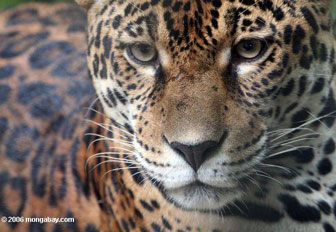The Department of Fish and Game in Arizona captured a jaguar south Of Tucson, Arizona and fitted it with a GPS radio collar. The jaguar, a well-documented male named ‘Macho’, is the first in the US to be fitted with such a collar, providing frequent updates on its movements.
The largest cat in the Americas has recently sparked a legal battle in the United States. Last year when the Bush Administration refused to protect the jaguar, the Center for Biological Diversity, an environmental non-profit group, filed a lawsuit in April 2008.
Currently, only four jaguars are known to inhabit the United States. It is believed that none of them originated there, but rather migrated over the border from Mexico. The last native-born jaguar in the US was killed in 1963 in Eastern Arizona.
 Will the jaguar survive in the United States? |
The most imminent threat for the recovery of the jaguar in the Southwest is continuing construction of the border wall. Eventually the wall will make it impossible for the few jaguars of the United States to breed with the larger population in Mexico, essentially dooming the few individuals who have crossed the border.
“Macho and other jaguars need President Obama to tear down the border wall and authorize a recovery plan and critical habitat protection,” said Michael Robinson of the Center for Biological Diversity in a press release. “That way Macho may find a mate, and future generations of jaguars will still find homes in our forests and deserts.”
The jaguar has not always been so rare in the Untied States; historically it ranged from California to the Appalachian Mountains. As many places in the US were settled the great car was eradicated for its fur and the concern that it would kill livestock.
The suit brought by the Center for Biological Diversity will be heard on March 23rd in Arizona.
Related articles
Camera trap photos reveal bushmeat hunting threat to jaguars in Ecuador
(01/27/2009)
Jaguars are the largest cats of the Americas and third largest cats in the world. The primary rainforest in the Amazon region of Ecuador is among their last remaining strongholds. Jaguars are listed as “vulnerable” in Ecuador, and Santiago Espinosa, Wildlife Conservation Society (WCS) fellow, PhD candidate from University of Florida/Gainesville, and WWF fellow, wants to know just how many jaguars are left in his home country. He is developing strategies to protect them by determining their numbers and the factors that threaten them through a unique method of non-invasive photography.
Bush Administration moves to weaken endangered speices protection by invoking new rationale
(07/31/2008)
The Bush administration’s handling of the Endangered Species Act has put the cactus ferruginous pygmy owl in danger of extinction, according to the Centre for Biological Diversity. Even though less than 30 individuals exist in the United States—all in Arizona—the species was removed from the Endangered Species Act in 2006, after nine years of protection.
Border fence may drive largest American cat to extinction
(01/22/2008)
The Bush Administration’s decision to not prepare a recovery plan for the endangered jaguar in its native habitat in Arizona and New Mexico may spell the end for the big cat in the United States, says an environmental group.
Central America agrees to jaguar corridor
(05/23/2006)
A group of environment ministers representing the seven nations of Central America and Mexico have agreed to establish a network of protected areas and wildlife corridors to safeguard jaguar populations, according to the New York-based Wildlife Conservation Society. The decision was made at the Second Mesoamerica Protected Area Congress held in Panama earlier this month. br>